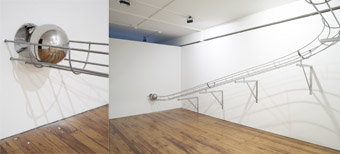beauties beyond irony and austerity
urszula dawkins: kel glaister & arlo mountford at conical inc

Busting Out, Kel Glaister
photos Christian Capurro, courtesy of Conical
Busting Out, Kel Glaister
AT MELBOURNE’S CONICAL INC., KEL GLAISTER INVITES US INTO A DE-CONSTRUCTION SITE THAT IS CLEAN AND BARE BUT FOR THE SLICK METAL RUNNER THAT CARRIES A GIANT BALL-BEARING TO ITS RESTING PLACE, EMBEDDED IN THE GALLERY WALL; WHILE ARLO MOUNTFORD OFFERS A COMFY SEAT AND FLUFFY WHITE ‘BEARSKINS’ AS THE SETTING FOR HIS QUIRKY FILM THAT FOLLOWS A RANDOM IDEA TO ITS LOGICAL CONCLUSION.
At face value, Mountford’s scenario is whimsical: a deer—well, a guy in an antler hat and ‘deer’ pants—wanders around the Victorian alps with a cuddly polar bear, discussing the making of art, until the two meet a real ‘Wanderer’, straight from C D Friedrich. They have a picnic in the snow, then wander some more. The work is the product of a filmed-but-forgotten late night conversation, which we see at the start of the piece: a drunken Mountford, inspired by a damaged neon sign that reads “—NDINAVIA”, paints a rambling verbal picture of a deer in a wintry forest, tossing snow with its antlers to the sounds of a massed chorus.
Mountford’s post-dubbed dialogue is a sardonic reflection on why an artwork is created and the inevitable compromises of its making. Artistic references abound—most markedly to Fischli and Weiss’s rat and bear films—as do self-referential loops of critique-within-critique. The cartoon-like bear seems to play the devil’s advocate, countering lofty statements with comments like “So you didn’t get funded.” (The deer replies, “Piss off.”) Mountford creates a clever, critical conversation about the artist’s pursuit of an idea: the culmination of this discussion is the ‘deer’ on his knees, ecstatically tossing snow, arching and turning in slow motion to a choir that sings ‘NDINAVIA’ over and over.
Return to Form: NDINAVIA seems to take the animated characters of Mountford’s previous works and bring them to life in the ‘real world.’ The mauve-tinted, snowy landscape is lush and alluring; and for all their absurdity, the hapless deer and cuddly bear padding through the wilderness are strangely appealing. As the rhetoric expounded by one so often falls comically flat against the banal response of the other, the theoretical weight that might otherwise alienate is lifted to another realm, one of sheer irony and playfulness.
The perfectly-drawn Wanderer in his cameo role gets the last laugh, in a sense, for the film’s sensual climax is a kind of sublime homage to all things Romantic; a triumph of ‘artistic vision’ that renders theory irrelevant. Beauty, in the end, reigns supreme and the artist stays true to his idea—even when the idea is an unremembered, drunken rant. Mountford’s film is completely engaging for its sheer oddness, and at the same time cleverly pulls off something both conceptually rich and visually seductive.
For Busting Out, a melting block of ice at the exhibition opening served to set Glaister’s ball rolling. Her elegant metal runner delivers it to its final destination, half-in, half-out of the gallery space it relies on for its existence. The work seems a streamlined version of the ideas that drove Glaister’s Immovable Object (2007, RT 80, p53). This time she uses polished steel rather than cinderblock, much as one might take up a well-tempered sword rather than a blunt club. The shiny, still sphere reflects the viewer, the room, the edges of the broken wall and the metal run itself. The space is empty and silent, but full of the imagined trace of the movement; the never-to-be-repeated gesture, the path of the ball through the gallery.
Far from Mountford’s directly tongue-in-cheek tone, Glaister’s installation appears to take itself seriously despite its claim to be “a bratty attempt to make itself defunct.” It is a deliberately futile effort: the wall itself is reinforced with steel plate so the ball can never in fact ‘bust out.’ The physical work is as sleek and sophisticated as the idea it articulates. The resulting hole is not random but perfectly round, an ‘embossing’ as much as a break—though this changed later in the exhibition’s run, when some gallery visitors mistakenly took the piece to be ‘interactive.’
Glaister’s piece is smoothly constrained, cool-headed, while Mountford’s film ultimately gives unashamed voice to the notion of beauty. But Glaister’s work has a seductive beauty nonetheless—where will her increasingly refined efforts lead in the future? Mountford seems indeed to be wandering in new territory, and it will be interesting to see what medium will be employed next in his exploration of the history of art and ideas.
Arlo Mountford, Return to Form: NDINAVIA; Kel Glaister, Busting Out, Conical Inc, Melbourne, Nov 8–29, 2008
RealTime issue #89 Feb-March 2009 pg.






